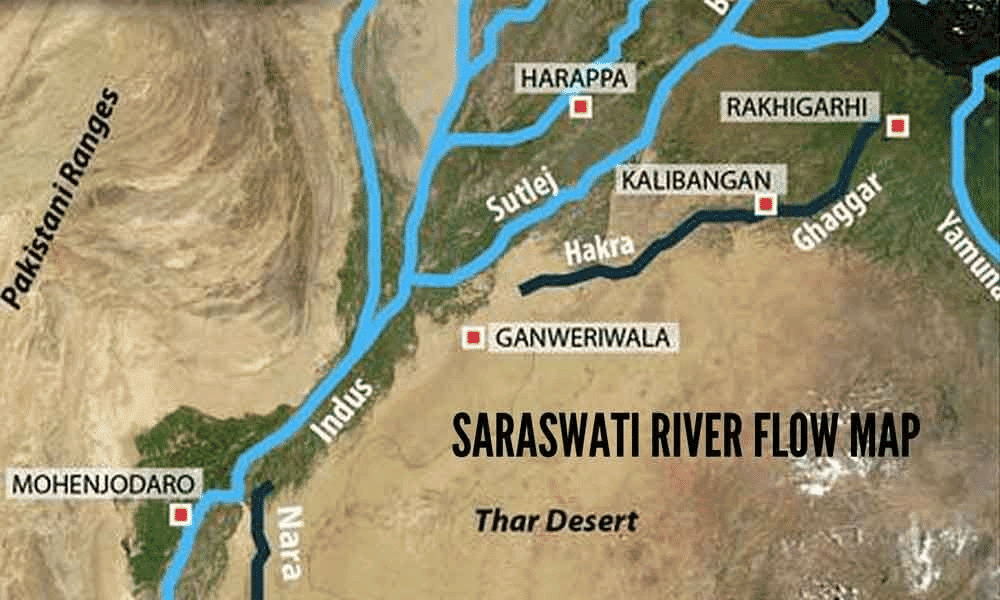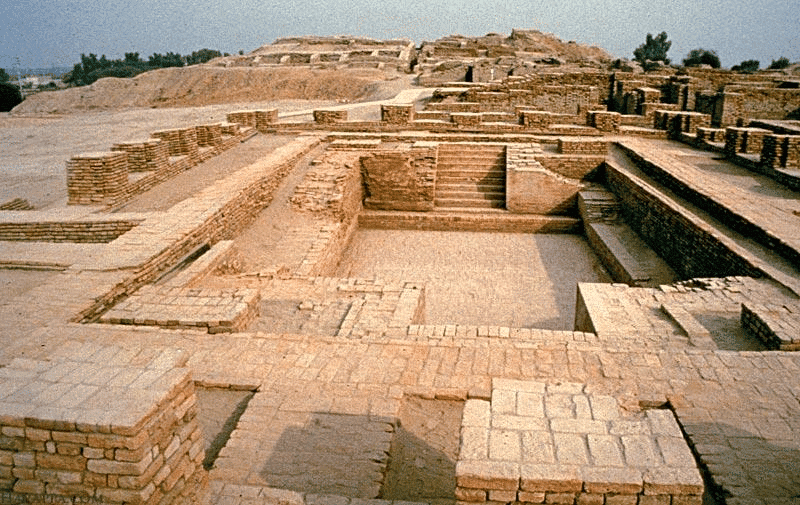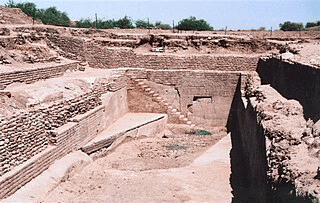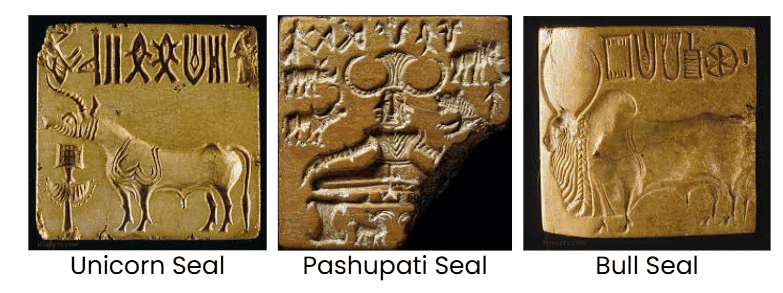Short & Long Question Answers: The Beginnings of Indian Civilisation | Short & Long Answer Questions for Class 6 PDF Download
Short Question Answers
Q1: What is a civilisation ?
Ans: A civilisation is an advanced stage of human society with specific features. It includes a government to manage people, planned cities with water and drainage systems, and various crafts like making tools and ornaments.
- It also needs trade within and beyond its region, a writing system for records, cultural ideas shown in art or customs, and enough farming to feed cities.
- These traits show how groups grow beyond simple villages, organizing life in complex, thriving ways, like the Harappans did long ago.
Q2: Why is the Harappan civilisation called by different names?
Ans: The Harappan civilisation is called Indus, Harappan, or Indus-Sarasvati because of its key areas. ‘Indus’ comes from the Indus River region where cities like Mohenjo-daro grew. ‘Harappan’ honors Harappa, the first city dug up over 100 years ago. ‘Indus-Sarasvati’ includes the Sarasvati River, once vital but now seasonal, where many sites thrived. These names reflect its wide reach across rivers and discoveries over time.
Q3: How did villages turn into cities in the Harappan civilisation?
Ans: Around 3500 BCE, villages in the fertile plains of Punjab and Sindh, watered by the Indus and Sarasvati rivers, grew into towns. By 2600 BCE, trade and exchanges expanded these into cities. The rich soil helped farming, supporting more people and bigger settlements. This shift, called the First Urbanisation of India, built the Harappan civilisation, with planned cities like Harappa and Mohenjo-daro rising from simple village roots.
Q4: What role did the Sarasvati River play in the Harappan civilisation?
Ans: The Sarasvati River, flowing from the Himalayas through Haryana and Gujarat, was key to the Harappan civilisation. It supported cities like Rakhigarhi and Kalibangan with water and fertile land for farming. Praised in the Rig Veda as a goddess and river, it later dried up, turning into the seasonal Ghaggar-Hakra. Its many sites show it was as vital as the Indus, shaping the civilisation’s growth until its decline.

Q5: How were Harappan cities planned?
Ans: Harappan cities were carefully planned with wide streets aligned to cardinal directions, like north-south.
- They had fortifications for protection and split into an upper town for elites and a lower town for others. Houses, big and small, used uniform bricks, showing equal building quality.
- Large structures like warehouses served everyone, while unique features, like Dholavira’s three zones, highlight their smart, organized layouts.
Q6: What was the Great Bath in Mohenjo-daro used for?
Ans: The Great Bath in Mohenjo-daro, a waterproof tank about 12x7 meters, might have been a royal bath or a religious ritual site. Surrounded by rooms with a well and drain, it wasn’t a public bath since most homes had bathrooms. Archaeologists debate its purpose—maybe for kings or ceremonies—because no texts explain it. Its careful design suggests it held special importance to the Harappans.
 Great Bath in Mohenjo-daro
Great Bath in Mohenjo-daro
Q7: How did the Harappans manage water in their cities?
Ans: The Harappans excelled at water management, building home bathrooms linked to street drains for waste. Mohenjo-daro had hundreds of brick wells, while Dholavira boasted massive stone reservoirs, the largest 73 meters long, connected by underground channels. These systems kept cities clean and supplied water from rivers, ponds, or rain, showing their focus on hygiene and smart planning.
 A large reservoir cut in the rock at Dholavira, measuring 33 metres in length
A large reservoir cut in the rock at Dholavira, measuring 33 metres in length
Q8: What crops did the Harappans grow?
Ans: The Harappans grew cereals like barley, wheat, millets, and sometimes rice near rivers. They also cultivated pulses, vegetables, and were the first in Eurasia to grow cotton for clothes. Living by the Indus and Sarasvati, they used fertile soil and tools like ploughs to farm enough to feed villages and cities, proving their agricultural skill supported a big population.
Q9: What animals did the Harappans domesticate, and why?
Ans: The Harappans domesticated animals like cattle, goats, and others for meat, as found in excavated bones. They also fished in rivers and seas, adding to their food supply. These animals, raised near settlements, provided protein since crops alone weren’t enough. This mix of farming and animal-keeping helped sustain their cities, showing a balanced way to live off the land.
Q10: How did the Harappans trade with other regions?
Ans: The Harappans traded actively, sending ornaments like carnelian beads, timber, gold, cotton, and possibly food to nearby and far-off places like Oman and Iran. They imported copper, scarce at home, using land routes, rivers, and sea paths. Coastal sites like Lothal had a huge dockyard for boats, proving they pioneered sea trade in India, connecting their crafts to the world.
Q11: What were Harappan seals used for?
Ans: Harappan seals, small steatite squares with animal figures and writing, helped in trade. Traders likely used them to mark goods or identify themselves, like labels or signatures. Found across settlements, these hardened stones show animals like bulls or unicorns, but their script and symbols remain a mystery. They hint at an organized system to manage the bustling exchange of goods.

Q12: What everyday objects did the Harappans make?
Ans: The Harappans crafted bronze mirrors, terracotta pots, stone weights, and bronze chisels for daily use. They also made fun items like gamesboards carved in stone and tiny terracotta whistles. These objects, dug up from sites like Dholavira, show they worked metals and clay skillfully, blending practicality with play, giving us a peek into their busy, creative lives.
Q13: What do Harappan artworks tell us about their culture?
Ans: Harappan artworks, like the bronze ‘Dancing Girl’ with bangles, a ‘Priest King’ statuette, and a pot with a thirsty crow story, reflect their culture. Seals with swastikas or three-faced deities suggest beliefs, while the ‘namaste’ figurine hints at gestures we still see. These pieces show skill, imagination, and traditions that lived on, linking their world to ours.
Q14: Why did the Harappan civilisation decline around 1900 BCE?
Ans: The Harappan civilisation declined around 1900 BCE due to climate change and the Sarasvati River drying up. A drier phase from 2200 BCE cut rainfall, hurting farming and food for cities. The Sarasvati’s loss left sites like Kalibangan empty. No signs of war appear—just nature’s shift. People returned to rural life, scattering into smaller settlements as cities faded.
Q15: How did Harappan culture survive after the cities ended?
Ans: After Harappan cities emptied around 1900 BCE, their culture didn’t vanish. Rural settlers kept using their farming tools, like ploughs, and crafts like pottery. Traditions, seen in bangles or stories like the thirsty crow, passed down too. Though the government dissolved, these skills and ideas flowed into India’s next phase, proving their ways outlasted the urban decline.
Long Question Answers
Q1: What are the key features that define the Harappan civilisation?
Ans:
- Governing Wisely: Had rulers and systems to organize complex city life.
- Building Smart Cities: Planned towns with streets and fortifications, like Harappa.
- Crafting with Skill: Made tools, ornaments, and goods from stone and metal.
- Trading Far and Wide: Exchanged beads and cotton with distant lands.
- Writing for Records: Used seals with the script to track trade and goods.
- Expressing Culture: Created art, like the ‘Dancing Girl,’ showing beliefs.
- Farming to Feed All: Grew crops like wheat to supply cities and villages.
- Managing Water Well: Built drains and reservoirs for clean living.
Q2: How did the Harappans plan and build their cities?
Ans:
- Laying Out Streets: Designed wide roads in straight lines, facing north or south.
- Dividing the Towns: Split cities into upper zones for elites, lower for others.
- Raising Strong Walls: Added fortifications to protect settlements from harm.
- Using Uniform Bricks: Built all houses, big or small, with the same quality bricks.
- Storing for Trade: Erected warehouses to hold goods for transport.
- Crafting Special Sites: Made places like the Great Bath, possibly for rituals.
- Cutting Rock Reservoirs: In Dholavira, carved stone tanks for water storage.
- Linking with Drains: Connected homes to underground drains for waste.
- Planning with Care: Showed advanced thought in every city’s layout and needs.
Q3: What did the Harappans eat, and how did they get their food?
Ans:
- Growing Grains: Farmed barley, wheat, millets, and rice for meals.
- Adding Pulses: Raised lentils and beans for extra nourishment.
- Cultivating Veggies: Planted vegetables to vary their diet.
- Pioneering Cotton: Grew cotton first in Eurasia for weaving clothes.
- Using Ploughs: Made clay ploughs to till fields efficiently.
- Raising Animals: Kept cattle and goats for meat supply.
- Fishing Waters: Caught fish from rivers and seas for food.
- Cooking Spices: Used turmeric and ginger, found in pots, for flavour.
- Feeding Cities: Villages sent crops daily to keep urban life thriving.
Q4: How did trade shape the Harappan civilisation?
Ans:
- Exporting Treasures: Sent carnelian beads, timber, and cotton abroad.
- Importing Metals: Brought in copper, rare in their lands, for tools.
- Sailing the Seas: Used Gujarat’s coast and Lothal’s dock for boats.
- Marking with Seals: Stamped goods with steatite seals for trade clarity.
- Crafting Fine Goods: Made shell bangles and bronze items to sell.
- Connecting Near Cities: Traded within their region for daily needs.
- Reaching Far Lands: Linked to Iran and Oman with ivory combs.
- Building Big Docks: Lothal’s 217-meter basin held trading vessels.
- Boosting Skills: Grew rich and skilled through this lively exchange.
Q5: Why did the Harappan cities fall, and what happened next?
Ans:
- Facing Dry Times: Climate turned arid from 2200 BCE, cutting rain.
- Losing Sarasvati: River dried up, abandoning cities like Kalibangan.
- Struggling with Food: Less water hurt crops, starving urban areas.
- Ruling No More: Government faded, leaving cities unmanaged.
- Shifting to Villages: People left for rural life by 1900 BCE.
- Keeping Old Ways: Took farming tools and crafts to new homes.
- Passing Down Tales: Kept stories, like the crow, in rural lore.
- Avoiding War’s Blame: No signs of fighting—just nature’s toll.
FAQs on Short & Long Question Answers: The Beginnings of Indian Civilisation - Short & Long Answer Questions for Class 6
| 1. What are the key features of the Indus Valley Civilization? |  |
| 2. How did the geography of India influence the development of early civilizations? |  |
| 3. What role did trade play in the Indus Valley Civilization? |  |
| 4. What are some theories about the decline of the Indus Valley Civilization? |  |
| 5. What evidence do we have about the social structure of the Indus Valley Civilization? |  |






















